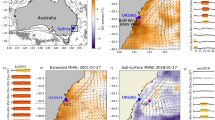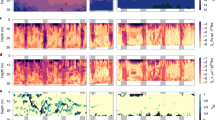Abstract
Mesoscale eddies are energetically dominant over most of the world's ocean1. The local dynamics of eddies is now a central problem of physical oceanography2 and their statistics control aspects of the general circulation3. The horizontal scale of eddies is generally related to, but somewhat larger, than the Rossby internal deformation radius (the depth scale multiplied by the buoyancy frequency divided by the Coriolis frequency). In the eastern Mediterranean, which is not well explored or understood, the internal radius is known to be 12 km or 4 times smaller than in the North Atlantic. The study of such eddies requires very fine sampling which hinders their accidental discovery. By using a dedicated data set and objective analysis methods, we have estab-ished the existence of small synoptic/mesoscale eddies and jets, which constitute a variable and turbulent current regime and dominate the general circulation flow of the Levantine basin. Their existence in the Mediterranean has an impact on all aspects of basic and applied marine science there, both conceptually and with respect to experimental and monitoring programme designs.
This is a preview of subscription content, access via your institution
Access options
Subscribe to this journal
Receive 51 print issues and online access
$199.00 per year
only $3.90 per issue
Buy this article
- Purchase on Springer Link
- Instant access to full article PDF
Prices may be subject to local taxes which are calculated during checkout
Similar content being viewed by others
References
1. Robinsoson, A. R. in Eddies in Marine Science (ed. Robinson, A. R.) 1–14 (Springer, Heidelberg, 1983). 2. Haidvogel, D. B. in Eddies in Marine Science (ed. Robinson, A. R.) 404–436 (Springer, Heidelberg, 1983). 3. Holland, W. R., Harrison, D. E. & Semtner, A. J. Jr in Eddies in Marine Science (ed. Robinson, A. R.) 379–401 (Springer, Heidelberg, 1983). 4. Ovchinnikov, I. M. & Fedorseyev, A. F. in Basic Features of the Geological Structure 185–201 (1965). 5. Ovchinnikov, I. M. Oceanology 6, 49–59 (1966). 6. Lacombe, H. News. coop. Invest. Mediter. 7, 5–25 (1975). 7. POEM Steering Committee UNESCO Reports in Marine Science No. 35 (Unesco, Paris, France, 1985). 8. Mooers, C. N. K. & Robinson, A. R. Science 223, 51–53 (1984). 9. Flierl, G. R. & Robinson, A. R. J. phys. Ocean. 7, 300–302 (1977). 10. Heinmiller, R. H. in Eddies in Marine Science (ed. Robinson, A. R.) 542–567 (Springer, Heidelberg, 1983). 11. Bretherton, F. P., Davis, R. E. & Fandry, C. B. Deep Sea Res. 23, 559–582 (1976). 12. Carter, E. F. & Robinson, A. R. J. atmos. ocean. Technol. (in the press). 13. Pedlosky, J. Geophysical Fluid Dynamics (Springer, Heidelberg, 1979). 14. Taupier-Letage, I. & Millot, C. Oceanologica Ada (in the press). 15. Robinson, A. R., Feliks, Y. & Pinardi, N. in Proc. Lend Workshop, Lerici, Italy 1984 (ed. Charnok, H.) (in preparation). 16. Le Groupe Tourbillon Deep Sea Res. 30, 475–511 (1983).
Author information
Authors and Affiliations
Rights and permissions
About this article
Cite this article
Robinson, A., Hecht, A., Pinardi, N. et al. Small synoptic/mesoscale eddies and energetic variability of the eastern Levantine basin. Nature 327, 131–134 (1987). https://doi.org/10.1038/327131a0
Received:
Accepted:
Issue Date:
DOI: https://doi.org/10.1038/327131a0
This article is cited by
-
A three-layer model of hydrodynamic processes in the Cyprus Eddy system
Ocean Dynamics (2024)
-
The hydrodynamic theory of the Cyprus Eddy
Ocean Dynamics (2022)
Comments
By submitting a comment you agree to abide by our Terms and Community Guidelines. If you find something abusive or that does not comply with our terms or guidelines please flag it as inappropriate.



